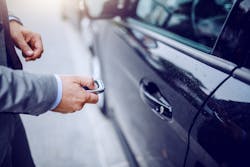Ultra-Wideband on the Near Horizon, dormakaba Says
If your mind already is reeling from the rapid proliferation of wireless protocols, such as Wi-Fi, near field communication and Bluetooth, get ready for another one that’s on the horizon: ultra-wideband (UWB).
We first heard about UWB at the virtual ISC West event in 2020. Ahead of the ISC West 2021 convention, we heard it again from at least one manufacturer — dormakaba.
While discussing how Switch Tech, dormakaba company BEST’s wireless smart-cylinder technology, fit in with touchless access control, Dan Stewart, technical business development lead at dormakaba, notes that dormakaba already is working on products that would include UWB technology.
“I think two years [from now] would be the threshold for implementation out in the marketplace,” he says. “We’re targeting our Alvarado team and our [door] operator team, and we have a lot of investment going into that technology.” Alvarado makes high-end turnstiles and other secured-entry solutions.
UWB is a wireless protocol that operates alongside other short-range technologies, such as Bluetooth, in the radio spectrum. It’s been around for various professional applications, such as advanced medical devices, but it’s starting to move into the consumer world. Several models of Apple and Samsung smartphones include UWB antennas, and at least one automobile model will include the technology in 2022.
UWB allows for the precise detection of objects at distances of up to about 7 feet. What that means in practical terms can best be explained by taking a closer look at the new automotive application.
The BMW iX, scheduled to arrive in the U.S. market in spring 2022, will use UWB as its door-opening technology. As soon as you’re within the necessary distance, the SUV will unlock automatically, turn on its lights and even start preconfigured, personalized settings, such as a customized welcome on the vehicle’s display. You don’t have to present a credential, just have a fob or even a digital key on a smartphone with you.
The most significant benefit, Stewart points out, is the increased security that UWB provides, specifically the elimination of credential spoofing, which can happen during a relay attack.
In a relay attack, thieves can fake a signal to a key fob — even if the fob were inside a home with the vehicle owner — that tricks the vehicle’s keyless entry system into registering that the fob is nearby. The thieves then can open and start the vehicle without the fob.
UWB eliminates or dramatically reduces the threat of such an attack, Stewart says, because of the precision with which the technology measures the distance between, say, a fob and the vehicle. In other words, thieves wouldn’t be able to open and steal the vehicle, because the UWB transmitter in the vehicle would recognize that the fob still was too far away to achieve any such functionality.
“It wouldn’t allow for that spoofing,” Stewart says, noting that this would have applicability not only in the auto industry but also with respect to access control.
Further, if a credential reader at a door that was tied to an access control system were equipped with UWB, all you would have to do is approach the door with a proper credential, and it would open automatically without you having to touch anything.
“It’s getting us to the point of ‘Star Trek,’” Stewart says of the seamless nature of doors in that series. However, one area that will require more innovation before such a scenario becomes reality, he adds, is how to get automatic door operators and automatic turnstiles to react with the appropriate speed to prevent injury.
About the Author
Will Christensen
Senior Editor
Will Christensen is senior editor at Locksmith Ledger International. He has been an editor and reporter at magazines and newspapers for more than 30 years.
